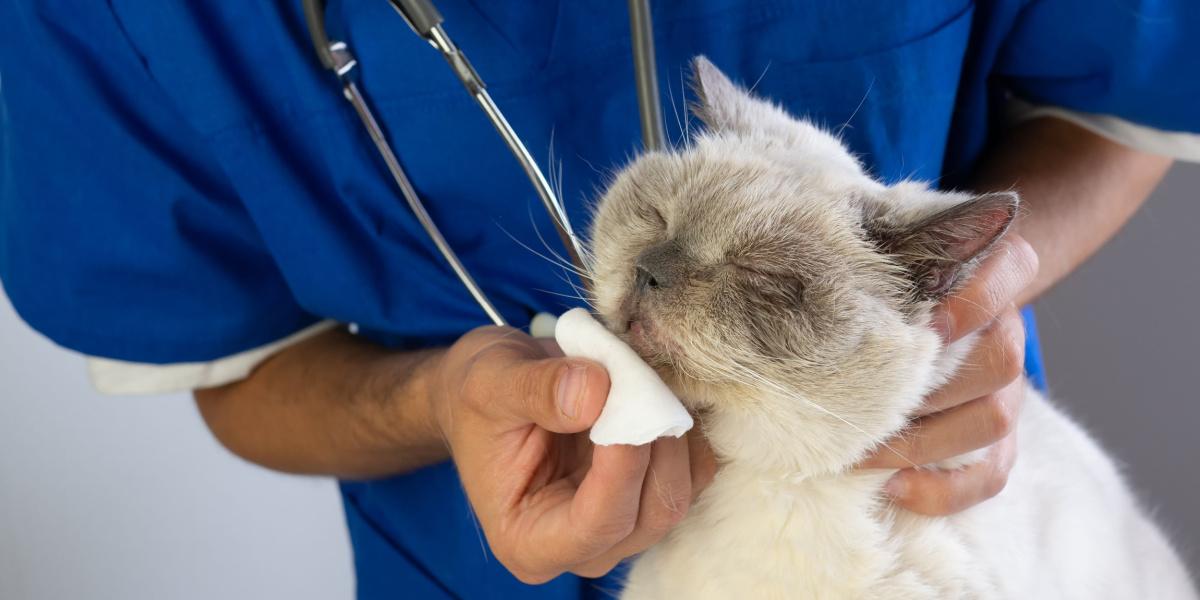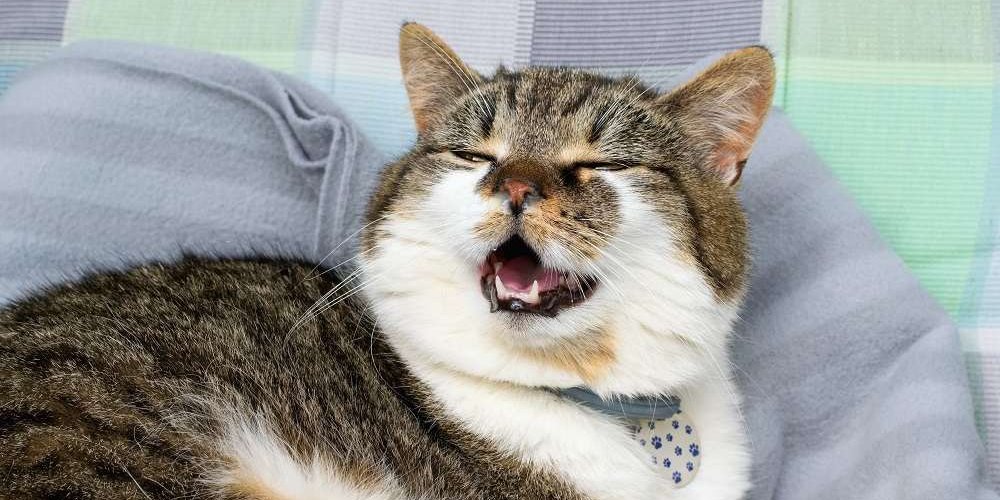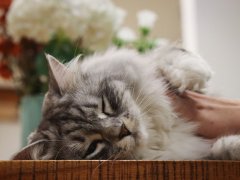
Yekatseryna Netuk / Shutterstock.com
Nasal discharge is such a common symptom in cats that it is likely your cat will suffer from it at some point in their life. The good news is that most causes of runny noses in cats are easily treated. Some cases—such as mild allergies or viral infections—might resolve without any treatment at all. But you can do some things at home to help your cat feel better as soon as possible.
There are a few serious causes of nasal discharge that are important to know, particularly if your cat is showing other signs of illness. Read on for everything you need to know about nasal discharge in cats, including when you need to see the veterinarian and what you can do at home to help.
Possible Causes of Nasal Discharge
Nasal discharge just means anything that runs out of your cat’s nose. Most often, this is a watery or snotty discharge, but it can occasionally contain blood or pus, which can be a sign of something more serious. Nasal discharge usually occurs due to inflammation, infection, or trauma within your cat’s nasal passages or airways. You might notice other symptoms alongside nasal discharge, depending on the cause.
By far the most common cause of nasal discharge in cats that I see as a veterinarian is an upper respiratory tract infection. Just like with colds in people, these are usually viral, but cats can also get bacterial and fungal infections, too.
Upper Respiratory Infections
Viral infections in cats are common. The two most common viruses in cats that cause upper respiratory symptoms (or “cat flu”) are feline herpesvirus (FHV) and feline calicivirus (FCV). Nearly all cats are exposed to one of these viruses at some point in life, and many go on to be carriers for the rest of their lives. This means that although affected cats might have long periods without symptoms, they often recur during times of stress or illness.
The frequency and severity of symptoms vary from cat to cat, but some cats will suffer from chronic signs. If your cat gets a snotty nose or runny eyes every so often, they are probably a carrier of one of these viruses—this is often called chronic rhinitis.
Viral upper respiratory infections often begin with a watery mucus discharge. In mild cases, many cats will not act very sick and have few other symptoms. These cases often resolve without treatment.
In more severe cases, cats usually have other symptoms, including sore eyes, sneezing, fever, and feeling generally unwell. The discharge might also become thicker or more yellow-green in color, indicating a secondary bacterial infection. If your cat has any of these signs, get them checked over by your veterinarian.
Although viruses are the most common cause of upper respiratory infections in cats, they can also get primary bacterial infections (such as Bordetella bronchiseptica) and fungal infections (such as Cryptococcus or Aspergillus).
Other Causes of Nasal Discharge

As well as upper respiratory tract infections, nasal discharge can be caused by anything from allergies to foreign bodies and even dental disease. Tunatura / Shutterstock.com
Upper respiratory infections are a common cause of runny noses in cats, but there are many other possible reasons your cat has nasal discharge, including:
- Allergic rhinitis: Like hay fever in people, some cats can suffer from a runny nose due to allergies. This is often seasonal, and the discharge tends to be clear and watery. Although they might also have red or runny eyes, they tend not to have many other symptoms.
- Irritants: Respiratory irritants can include anything from dust to smoke, air fresheners, and even household cleaners. Irritation of the nasal passages can cause discharge and sneezing.
- Foreign bodies: If your cat inhales a foreign object (such as a blade of grass) it can lodge in their nasal passages and cause inflammation. The symptoms usually come on very suddenly and often include sneezing and irritation as well as nasal discharge.
- Nasal polyps: Nasal polyps are benign (non-cancerous) growths that can form in the nasal passages of cats, causing sneezing, congestion, reduced airflow, and nasal discharge. They usually occur in kittens but can affect cats of any age. Symptoms usually only affect one nostril.
- Nasal tumors: Cancer (neoplasia) of the nasal passages is often aggressive and difficult to treat in cats. Symptoms can begin with a mild nasal discharge, but they usually progress to include facial swelling, pain, reduced airflow, and thick or bloody discharge. You might also notice weight loss and other signs of being unwell.
- Dental disease: Severe dental disease or infection can lead to discharge from the nose if an opening develops between the nasal and oral cavities, called an oronasal fistula. Nasal discharge is often just from one nostril, and cats usually have signs of mouth pain.
Blood-tinged nasal discharge isn’t common in cats, but it can be a sign of something serious. Nosebleeds can be caused by trauma, clotting disorders, poisoning, cancers, and tick-borne disease. If your cat has a nosebleed, you should seek veterinary advice right away.
When To Call the Vet
A runny nose doesn’t always warrant a trip to the veterinarian if your cat is acting normally. In most cases, a mild nasal discharge will clear up on its own within a few days with a bit of TLC. I tend not to prescribe medication for cats with runny noses who are otherwise alert and well.
However, if your cat is developing other signs of illness or if the discharge is not getting better within a few days, it’s always best to get them checked. Common signs to look out for include:
- Reduced appetite
- Snotty discharge
- Lethargy
- Not drinking
- Frequent sneezing
- Red, sore eyes
- Fever
When I see cats with these symptoms in the clinic, I almost always recommend some supportive treatment to help them recover more quickly—even if I suspect they’re suffering from a common virus.
There are also some more serious symptoms you should look out for when it comes to nasal discharge in cats. If your cat is struggling to breathe, has pus or blood coming from the nose, or is very lethargic, take them to the veterinarian right away.
Treating Nasal Discharge
Many mild cases of nasal discharge in cats clear up with no treatment at all. But if your cat feels unwell, your veterinarian will likely recommend some treatment. This tends to fall into two categories: supportive treatment (treating the symptoms) and specific treatment (treating the cause).
Supportive Treatment
A lot of the time, we don’t know for sure what’s causing the nasal discharge, so we give some non-specific treatment to support your cat’s body while they’re clearing the underlying cause on their own. This treatment varies depending on what symptoms they have. If your cat has a high temperature, we often use a non-steroidal anti-inflammatory medication to help bring this down. Treating the fever usually makes cats feel much better and helps to get them eating and drinking well again.
One of the simplest and most effective treatments I prescribe is decongestants. Cats usually breathe through their nose, meaning a blocked nose can be very distressing. It also affects their sense of smell, which is a huge part of stimulating their appetite. Decongestants can help clear their nasal passages, making it easier for them to breathe and smell their food. This can make a really big difference to a cat that is feeling really under the weather.
Other supportive treatments your veterinarian might offer include nebulizers, appetite stimulants, and fluid therapy.
Specific Treatment
To offer more specific treatment, your veterinarian must determine what’s causing your cat’s nasal discharge. In some cases, they might have a strong suspicion based on their physical examination and the history you give. However, they will often need to run some tests, such as blood tests, diagnostic imaging (x-rays or CT scans), viral screening, biopsy, or testing of the nasal discharge itself to reach a diagnosis.
Once your veterinarian has a better understanding of what is causing the problem, they might recommend targeted treatment, such as:
- Antibiotics, if they suspect a bacterial infection
- Anti-viral medications
- Anti-fungal medications
- Antihistamines, if they suspect an allergy
- Corticosteroids
- Non-steroidal anti-inflammatories
- Dental work
- Removal of a foreign object
- Surgery
- Chemotherapy
Help Your Cat at Home

There is a lot you can do to help your cat with nasal discharge recover at home. larisa Stefanjuk / Shutterstock.com
First and foremost, follow any advice from your veterinarian. But there are some little tips and tricks you can use at home to help your cat feel better quickly, alongside whatever treatment your veterinarian has recommended.
Encourage Eating and Drinking
When we’re feeling under the weather, we often don’t feel like eating or drinking much, but we know we need to keep our strength up. Unfortunately, our pets don’t know this. This means they can end up becoming much sicker from simple illnesses. Encouraging them to eat and drink is one of the best things you can do at home.
Drawing on her experience nursing cats in hospital, registered veterinary nurse Lacey Pitcher, RVN, says, “Although the problem may be nasal discharge, cats tend to rapidly lose their appetite if they can’t smell. Smelly, tasty food is a must.”
Gently warming up some soft, wet food can enhance the smell and encourage your cat to eat. Strong-smelling foods like canned fish can also be a favorite.
Wet food is more palatable, softer for their throat, and helps keep your cat’s fluid intake up compared to dried food. As always, make sure they have easy access to fresh water nearby.
Try a Steam Room
Using a humidifier with plain water can help break up the mucus in your cat’s nose, allowing them to breathe more easily. Just don’t add any treatments to the water, such as essential oils, as these are likely to irritate your cat. You can also bring your cat into the bathroom while running a hot bath or shower so they can breathe in the warm steam. (Never put your cat near a heat source like boiling water or a tea kettle.)
Keep Their Eyes and Noses Clean
If your cat will let you, try to keep their eyes and nose clean. Use a soft cotton pad dampened with warm water to very gently remove any discharge from their eyes or nose. This will help reduce nasal congestion and discomfort. It also helps prevent sores that can develop from chronic ocular and nasal secretions. Our top tip is to use slightly warm water, as most cats tolerate this a little better.
Prevention of Nasal Discharge
Runny noses can be hard to avoid completely, but there are things you can do. The most important thing is to keep your cat’s vaccinations current. The most common cause of nasal discharge in cats is a viral infection, particularly herpesvirus and calicivirus. Both these viruses are included in your cat’s core vaccines.
Even if you suspect your cat already carries an underlying virus, there is still plenty you can do to help. Most affected cats go long periods with no symptoms at all, but flare-ups are often triggered by stress. So, registered veterinary nurse Eleanor Elliott, RVN, recommends ensuring your cat has a stress-free home. Her top tips are “lots of hidey places, plug-in pheromone diffusers, beds at various heights, and multiple litter trays in multi-cat households.”
Whatever the cause, whether it is an allergy, virus, or some other respiratory illness, if your cat is prone to nasal discharge, try and reduce respiratory irritants at home. Steer clear of air fresheners and diffusers, strong household chemicals, smoke, and anything else you notice irritates your cat.
Frequently Asked Questions
Why does my cat’s nasal discharge smell bad?
A foul-smelling nasal discharge in a cat indicates that they might have an infection. If you notice pus or a thick yellow or green discharge from your cat’s nose get them checked over by your veterinarian.
How long do upper respiratory infections last in cats?
Symptoms of upper respiratory tract infections can last anywhere from a few days to weeks, depending on the severity. Many cases are caused by underlying viruses that cats carry, and flare-up at times of stress. This is why some cats seem to get frequent bouts of runny eyes and noses.







